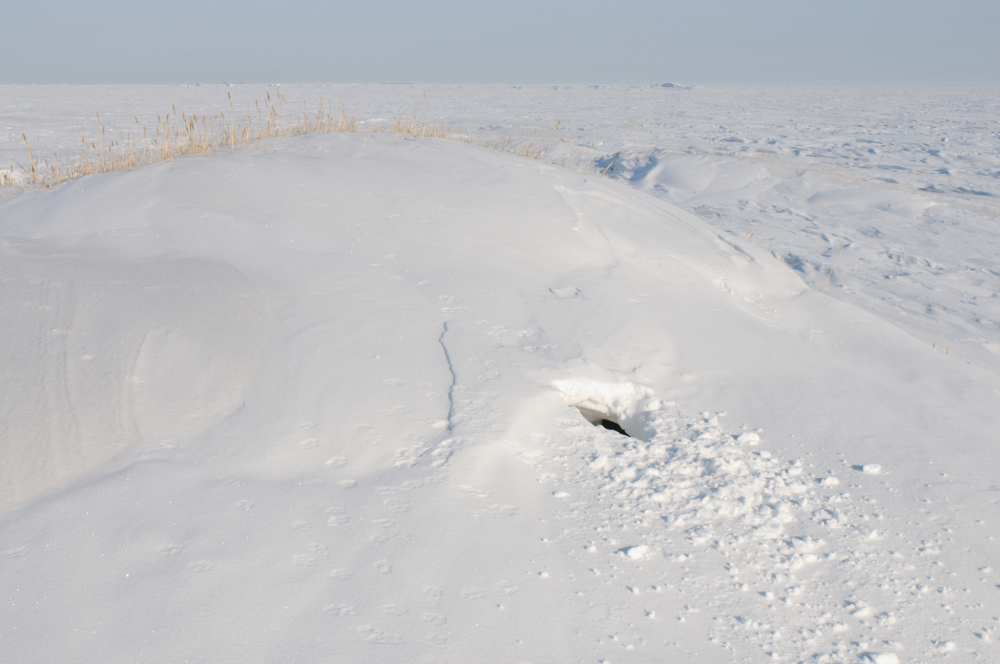Scientists have provided an unprecedented glimpse into the lives of denning polar bears, becoming the first to combine GPS satellite collar data with remote-operated cameras to study the first few months of cubs’ lives. Conducted by researchers from Polar Bears International (PBI), San Diego Zoo Wildlife Alliance, the Norwegian Polar Institute, and the University of Toronto Scarborough, it captured detailed footage of polar bear cubs emerging from their dens for the first time, over a staggering period of almost 10 years in Svalbard, Norway.
ADVERTISEMENT
When the time comes for a female polar bear to have her cubs, she’ll build a den that will become home for several months. As PBI’s Dr Louise Archer, Postdoctoral Research Fellow at the University of Toronto Scarborough, told IFLScience, females tend to return to the same areas for denning, and once inside the cubs get cooking.
They’re extremely underdeveloped when they’re born… They’re only about 600 grams, so very tiny, and they’re almost hairless with just a very faint covering of fur.
Dr Louise Archer
“She’ll enter her den, typically anywhere from October to November and during that time her fertilized egg will begin developing,” Archer told IFLScience. “It’s only about 60 days of active gestation in polar bears, quite a short active gestation period, and the cubs will be born from December through to January.”
“They’re extremely underdeveloped when they’re born, what we call altricial. They’re only about 600 grams [about a stick of butter, FYI], so very tiny, and they’re almost hairless with just a very faint covering of fur. They’re also born blind, so they’re really reliant on their mother during that time.”

Polar bear den in Prudhoe Bay, Alaska (2009), demonstrating why they aren’t easy to find.
Image credit: BJ Kirschhoffer / Polar Bears International
Monitoring polar bear moms and their cubs during this vital time in their development is becoming a matter of increasing importance, says Archer, as humans’ footprint on the Arctic expands. It’s hoped that by introducing new tools to monitor bears during these vulnerable months, scientists can gain critical insights into their behavior that could be used to support more effective conservation strategies.
We saw one family that left after only two days at the den, while another family stayed for a month.
Dr Louise Archer
This study marks a leap forward in maternal den research as it became the first to combine satellite tracking collars with remote camera traps to answer questions about polar bear denning – something that’s been notoriously difficult to study owing to how hard dens are to spot against a snowy landscape. This novel methodology enables scientists to study polar bears without disturbing them, and has already revealed curious insights into how they behave during these crucial months.
“It’s really interesting to see the footage,” said Archer. “What struck me was the amount of variation we saw. Each den had its own story.”
Monitoring the denning bears revealed that they don’t all emerge in the same way, as there was variation in how long they spent outside the den before going back in, and how quickly the den was abandoned altogether.
“In some cases, we saw females that emerged and only hung around for a very short time. We saw one family that left after only two days at the den, while another family stayed for a month. We saw a lot of this variation and that was very striking.”
ADVERTISEMENT
“Now we’re looking at what are some of the driving forces behind this variation. We also saw some really different behaviors. For example, two females moved dens after they first came out of their original den. So the mother dug a new den in the snow and moved her family there. Again, that generates new questions: Why did she move? What were the conditions in the original den that caused her to move elsewhere? What are the consequences of this for the polar bears and for their cubs?”
Answering these questions can feel like a race against time in the era of “drill, baby, drill,” but the research provides the foundation for improved wildlife management for these magnificent animals, enabling the reduction of potential clashes between polar bear denning areas and human activity.
Want to hear more? Check out the April issue of CURIOUS from March 30 for more from Archer, or hear the full conversation in a future episode of IFLScience’s podcast, We Have Questions.
The study is published in the Journal of Wildlife Management.
Source Link: Incredibly Rare Footage Shows Polar Bear Cubs Emerging From Dens In Unprecedented Detail